#Indian Students In Europe
Explore tagged Tumblr posts
Text
youtube
Are you looking to study, work, and settle in a European country? Then this video is for you. Explore the opportunities to study, work, and settle in the top European countries.
Find your ideal study abroad destination now!
Get FREE Admission and Visa Process Assistance: https://www.edugoabroad.com/study-in-europe-fall-2024-intake/
Still have questions? Reach out to us at +91 70690 07131/32/33.
SUBSCRIBE NOW for more such videos: YouTube: https://www.youtube.com/channel/UCJlDZP7ujFD0E3eJjY_kdAA Follow us on Instagram: https://www.instagram.com/edugo.abroad/ Facebook: https://www.facebook.com/edugoabroad LinkedIn: https://in.linkedin.com/company/edugo-abroad Twitter: https://twitter.com/Edugo_Abroad
#Study Abroad#Europe Education#Indian Students In Europe#Study In Europe#Higher Education In Europe#Study In France#Study in Germany#Study In Ireland#Study In Denmark#Study In Poland#Work Opportunity In Europe#Settle in Europe#European Student Life#Youtube
0 notes
Text
IELTS Coaching in Hyderabad – Right Turn Overseas
Boost your IELTS scores with expert coaching from Right Turn Overseas in Hyderabad. Our training ensures you meet language requirements for studying abroad in top universities.
#Best Overseas Consultancy in Himayat Nagar#Study Abroad Consultants in Hyderabad#Study Abroad Consultants in India#Student Visa Consultancy Services#Top Overseas Education Consultants#How to apply for a UK student visa from Hyderabad#Best immigration consultants for Europe#Study abroad tips for Indian students#IELTS Coaching in Hyderabad#Study abroad consultants#Consultancy in Hyderabad for abroad studies#Top study abroad consultants in Hyderabad#UK overseas consultancy
0 notes
Text

Want to know more? Click here.
1 note
·
View note
Text
youtube
Top 5 MBBS Universities in Russia for Indian Students - Fees Structure by Poornima Chauhan | #Eklavyaoverseas
#mbbsinrussia#mbbs russia#mbbs in russia for indian students#top universities in russia for medicine#poornima chauhan#eklavya overseas#mbbs in europe#mbbs in abroad#best fmge passing percentage#nmc guidelines#Youtube
0 notes
Text
The Ultimate Roadmap to Free Education at Public Free Universities in Germany
Tuition fees are one of the main concerns of international students. Thankfully, several public free universities in Germany aim to eliminate inflated tuition fees from the equation. Public free universities in Germany with free certification are free for all: not just students from the European Economic Area (EEA). By “free,” we mean these universities don’t charge astronomic enrollment fees. Some administrative charges may apply. But, paying partial tuition fees to public free universities in Germany is much, much cheaper than paying full tuition fees at any European college. Are you a young Indian student planning to do your master's or study MBA in Europe for free? For 15+ years, European Study Institute has helped hundreds of Indian students overcome language barriers and gain entrance into German universities. Is Education Free at Public Universities in Germany? Most “tuition-free” German universities charge students administrative, enrollment, and other basic student services fees. Apart from these semester-wise payments, there are no annual or monthly tuition fees that students have to pay at either bachelor’s or master’s level. Some postgraduate or post-employment level courses may carry semester fees (e.g., for advanced MBA courses). These fees are called “Semesterbeitrag” & they amount to €300-400 per month. In comparison to private institutes, these fees are substantially lower in German public universities. Getting a free MBA in Germany for Indian students also involves the following living costs: Rent/Utilities: €350-500 € Food/Drink: €200 Health Insurance: €100 Phone/Internet: €30 Students can easily get by on less than €900 per month. Can I Apply for Scholarships at Free Public Universities in Germany? Visit the official website of the German Academic Exchange Service (DAAD) to find an up-to-date list of scholarship programs from private and public universities in Germany. Can I stay in Germany after Finishing My Course? Yes. All international graduates, regardless of their educational background or country of origin can apply for a one-and-a-half-year residence permit post-graduation. These “post-study work visas” allow students to apply for any job that suits their qualifications. How to Apply to Free Public Colleges in Germany? Different public universities in Germany have different application processes, deadlines, and student requirements. Here’s a list of the most highly-rated public free universities in Germany with links to their websites: Free University of BerlinHumboldt University Berlin Technical University of Berlin University of Hamburg Trier University RWTH Aachen University University of Heidelberg University of Bonn University of Duisburg-Essen Visit these websites to check out their current requirements regarding non-European International students. For more info, visit the DAAD website, Germany-based study portals, and Facebook Groups that consist of International students. How to Get into a German Public University? Plan in advance, build a strong academic and extra-curricular portfolio, and give yourself a few months to complete the application process. Most importantly - learn the language. If you need extra help, contact our German educators at the European Study Institute!
#free mba in germany for indian students#best free certification courses for computer science engineers Germany#public free universities in germany#study mba in europe for free#Free Data science and artificial intelligence in Germany
0 notes
Link
Europe is a continent of diversity, culture, and innovation. It is also a continent of excellence in education, research, and career opportunities. If you are looking for a place to pursue your higher education goals, Europe might be the perfect choice for you. However, you need to know the Europe study visa requirements before you can study in Europe.
0 notes
Text

#best abroad education consultancy#Study in Abroad#study in foreign country#study abroad consultants#study in uk#study in usa#study in europe#Study in germany#top education consultants in india#study in foreign country with scholarship#education consultants in hyderabad#best consultancy for germany in hyderabad#best overseas education consultants in hyderabad#education in Abroad#best educational consultancy#higher study in germany for indian students#best canada education consultants in hyderabad#study in uk for indian students#uk student visa consultants in Hyderabad#Best UK Education Consultants in Hyderabad#Best UK overseas education consultants in Hyderabad#Study in UK consultants in Hyderabad#Best consultancy for the USA in Hyderabad#USA abroad educational services in Hyderabad
1 note
·
View note
Text
Study in Europe for Indian Students
Study in Europe for Indian Students- European countries are the home of top universities and educational institutions. They offer a wide range of accredited programmes to Indian students at affordable cost. From application to visa assistance & student loans, Superbstudyabroad will guide you at every step | 24x7 support. Find information on top universities, IELTS coaching, financial help and Visa. To get free & Complete Expert consultation, call us on +91 9654187866.
Read More: https://superbstudyabroad.com/study-in-europe/

0 notes
Text
https://www.edugoabroad.com/
europe education consultants
overseas education consultants
abroad education consultants
#Europeeducation#europe education for indian students#ahmedabad#india#overseas study consultants#study in france#study in uk#study in ireland#study in poland#study in denmark
0 notes
Text
Details and analysis of 3H outfits
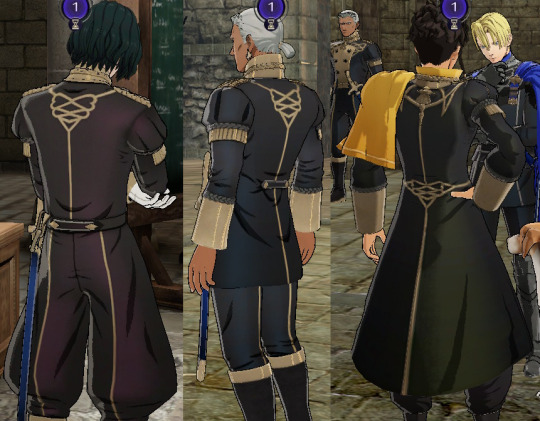
There is a reflection of the house color in the uniforms of students. Although the examples presented in the image are non-recruitable characters, when you recruit students, the color of the reflection in their uniforms will change to the color of your chosen house.

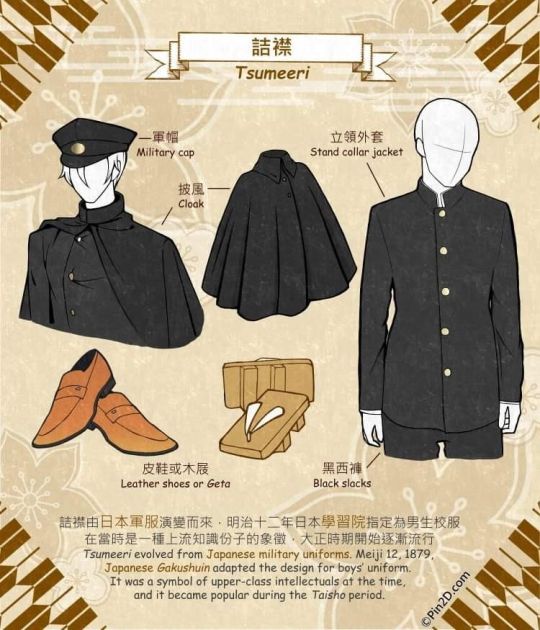
The Byleth academy uniform concept is based on the concept of student uniforms in modern japanese media. Such as the female uniform, which is based on a japanese female student uniform in terms of a hairband, short skirt, andwhite stockings. The male uniform is based on a uniform from the Taisho period.
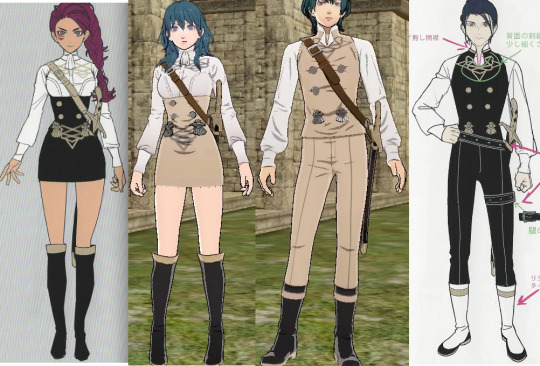
Female summer clothing is based on the Patra's uniform with the color scheme reversed, the reason may be due to Petra's nature that adapts to hot weather. However, male summer clothing is based on Felix's uniform🤔
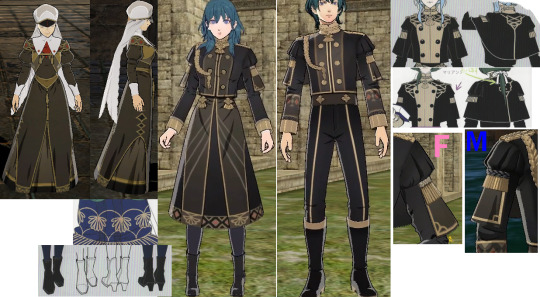
The evening wear consists of an Aiguillette which symbolizes honour, and a stylized design of Pellegrina which has a rhombus (males) and heart (females) shape on its edges, with a standard CoS pattern on the males sleeves and females skirts. The female skirts specifically are the same design as the nun's which both contain the pattern of Sothis' dress. Since the evening wear is intended to celebrate Garreg Mach's establishment, it is only natural that the design combines a formal uniform with CoS clothing.
Duscur
The children wear clothing similar to ancient Egyptian clothing, but the clothing of the man and woman closely resembles those of northern europe. (However, I may be wrong, so feel free to add to this post if you know more about the type of clothing of the Duscur people)
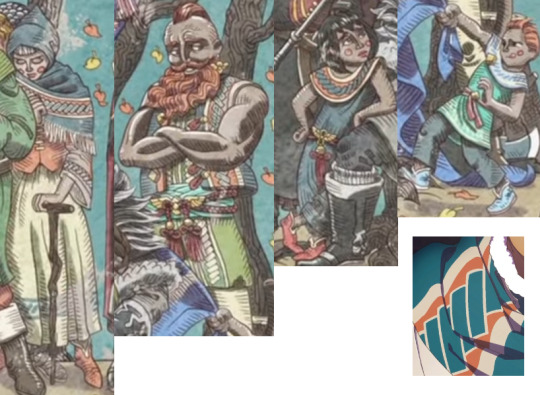
All clothing of the Duscur people of this feature a pixelated pattern, and color schemes of teal, light orange, vanilla, and red cords.
The design of their jewelry appears to be a mixture of wing symbols from cultures such as American Indians, Egyptians, and Persians.
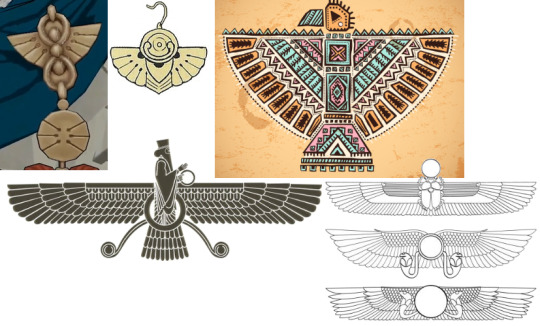
Almyra
This man from the VW end mural wears clothing similar to Nader's, and with a color scheme similar to Claude's and the color purple, which symbolizes royalty in persian culture, he is very likely the king of Almyra.
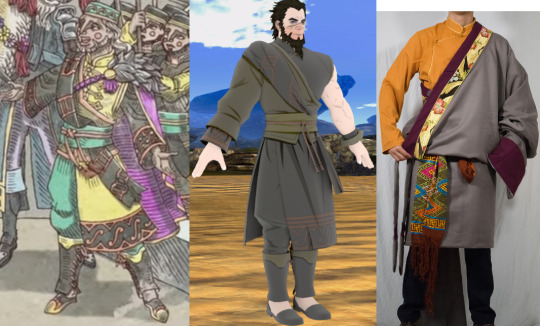
What I found interesting is that although Almyra is inspired by Persian culture, Nader and king's clothing is similar to Tibetan clothing. However, this is not a problem, there is no shame in drawing inspiration from a number of different cultures to make a culture in a fantasy story, as is the case with Duscur.
Dagda
From the clothing of the man on the camel and the helmets of the soldiers, Dagda appears to be inspired by Ottoman culture.
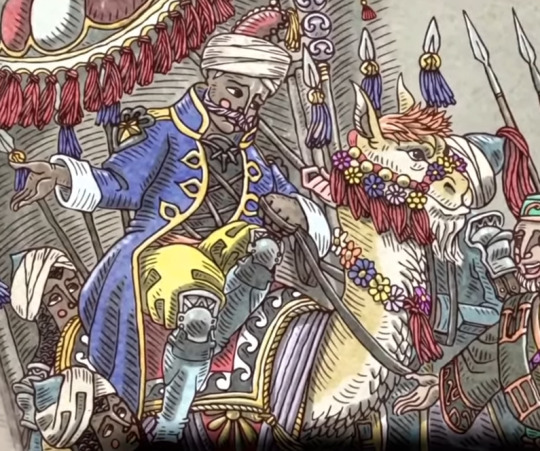
The reason I believe they are from Dagda is because there are many Shamir's design elements at their design.
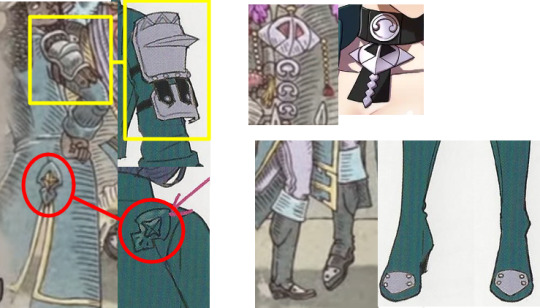
Well, my statement that "there is no shame in drawing inspiration from a number of different cultures to make a culture in a fantasy story," this is an example of the opposite.
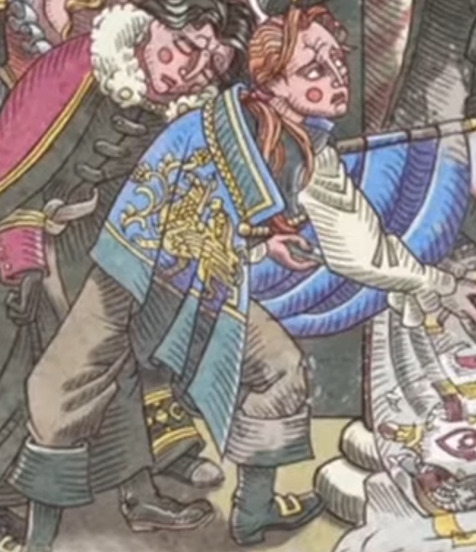
This man from the CF end mural wears the emblem of the kingdom, but his clothing style is that of the alliance. Why🤔
To know the difference between the clothing style of Fodlan countries, read this.
591 notes
·
View notes
Text
Emergence of Europe As A Top Study Destination and What the Future Holds
At EduGo Abroad, we have witnessed a steady uptick in the number of Indian students opting to study in Europe, particularly in countries like Ireland, Germany, Denmark, and so on. For the longest time, students would generally perceive the US, Canada, Australia and the UK as the places where one ought to be.
It’s not that Europe wasn’t seen as a coveted destination, but students were usually inclined towards studying in the aforementioned countries as they felt that their economic standing and policies were conducive to their cause of finding a job and possibly settling down in that country for the foreseeable future. When the pandemic was at its peak, foreign education didn’t skip a beat as the number of students leaving for these countries annually continued to rise and was forecasted to rise close to 2 million in 2024-2025.

This really hasn’t been the case though, however. In fact, overall interest has declined this year as suggested by an analysis of their own database by education financer GyanDhan. The analysis, conducted across state lines, concludes that there “has been a significant 22% drop in the number of students looking for abroad education loans as compared to the same period last year. This decrease in interest was even more pronounced in some states. Telangana witnessed a 30% drop and Gujarat, a 35% drop.”
Heart of the Matter
What could be driving this? Well, as far as we’ve observed, the job markets in these countries haven’t really fared well, and students have had a hard time finding and holding down jobs. It was always difficult to find jobs in non-tech fields, but it has now been exacerbated further, meaning that more and more students are returning home. This is far from ideal as a lot of students intend to cover their initial outlay, in terms of fees amongst other miscellaneous expenses, through the jobs they land there after concluding their studies.
In Australia, stricter scrutiny of applications from Indian students and doubling of fees has contributed to the downward trend. The UK contemplated restricting student entries even further, meaning that students, especially those who intend to pursue a non-tech education, aren’t as keen about these countries as they used to be.
Where One Door Closes, Another Opens
While on one hand the declining numbers across the board make for an interesting study by themselves, what should pique the interest of everyone in the spectrum of foreign education is the increasing interest in pursuing an education in countries such as Ireland, Germany, and Spain, among others. In the past few years, we’ve observed students are beginning to explore options other than the conventional ones, and there’s a growing realization as to the number of amazing, seemingly understated foreign education options, the vast majority of which are in Europe.
In our experience, students are attracted to these countries as they have assumed a more international student-friendly approach; application processes that are easier to navigate, more fluid visa processing, providing students with more flexibility in terms of working whilst studying, not compelling students to take IELTS/TOEFL, and so on. If we are to gaze at the numbers themselves, “there’s a 100% increase in interest in Irish universities among aspirants in Gujarat, Telangana, Tamil Nadu, Andhra Pradesh, and Karnataka”, according to GyanDhan’s analysis.
The Need for Measured Perspective
Before someone reading this gets carried away, it is imperative on our part as experienced and responsible foreign education consultants to implore prospective students to understand what studying in Europe is all about, understand their own plans, and contemplate accordingly.
To put it in the simplest of terms, one must avoid seeing Europe as “easy migration”. Whenever we provide advice to prospective students, we tell them that Europe isn't akin to Canada - one cannot emigrate simply by enrolling themselves in a random course to facilitate their stay and eventually earn permanent residency whilst working on the side. Europe is very, very open to people studying, working, and even settling down there, but it has to be meaningful - one must choose their course carefully, evaluate how it shall help their career path, and whether the skills they’d earn are in-demand so as to help them navigate the job market. Therefore, if one is seeking easy migration, Europe might not be the right move.
One must also take into consideration that every country in Europe has its own unique language and cultural disposition. It is not just paramount to learn the language, but also to embrace the culture there. Students can get by with English during their study, but could struggle once they step into the job market since a lot of things in Europe are done in the native language of the country. In any case, being multilingual is a major plus on one's CV and adds to their personal growth, so when one picks Europe, it is important to be receptive to learning the language and the way of life there. To sum it up, if one is serious about carving out a meaningful career and is willing to put forth the effort to learn the language and mingle with the local culture, then Europe represents an immense opportunity.
Conclusion
All in all, even if there have been challenges owing to socio-political situations unfolding around the world, there’s cause for optimism. Indian students’ general interest in pursuing a foreign education isn’t going to die down anytime soon as the desire for top-quality education and a higher standard of life is ubiquitous amongst an upwardly-mobile, aspirant middle class. The way we see it - this is more akin to diversification and students spreading their options out amidst growing options, as opposed to a decline.
#best Europe education consultant#country in Europe#easy migration#Europe As A Top Study Destination#foreign education#Heart of the Matter#study abroad#study in Denmark#study in Europe#Study in Europe for Indian Students#study in France#study in Ireland#study in UK#top-quality education
0 notes
Text
IELTS Coaching in Hyderabad – Right Turn Overseas
Boost your IELTS scores with expert coaching from Right Turn Overseas in Hyderabad. Our training ensures you meet language requirements for studying abroad in top universities.
#best study abroad consultants in hyderabad#study abroad assistance in hyderabad#overseas education consultants hyderabad#study abroad services hyderabad#IELTS Coaching in Hyderabad#Best Overseas Consultancy in Himayat Nagar#Study Abroad Consultants in Hyderabad#Study Abroad Consultants in India#Student Visa Consultancy Services#Top Overseas Education Consultants#How to apply for a UK student visa from Hyderabad#Best immigration consultants for Europe#Study abroad tips for Indian students#Study abroad consultants#Consultancy in Hyderabad for abroad studies#Top study abroad consultants in Hyderabad#UK overseas consultancy
0 notes
Text

The best European country where you can pursue your higher education without IELTS and at an affordable cost. Contact Now
#study abroad#study europe#educaion#czech republic#czechia#indian students#kerala#kochi#best educational consultancy
1 note
·
View note
Text
youtube
#college#student life#exams#university#teaching#Romania#mbbs#mbbs in romania#mbbs romania#mbbs in europe#mbbs in abroad#indian students#fees structure#language barrier#Youtube
1 note
·
View note
Text
Namaste! Welcome to my blog 🫶🏾 I wanted make a quick intro post for my HL oc, who’s been sitting in the lonely confines of my notes app for far too long!
Currently writing a fic called ‘The Princess and the Parselmouth’ which is on my tumblr!! (Thank you to @butternutt613 for the name!!)
The way Hogwarts works in this universe is that it is also an institution where higher education is offered. Namely, college and graduate school. In this universe, the HL crew are all grad students completing a phD/ Masters (I really like expanding the wizarding world’s academic lore because wdym they just go get jobs after high school?)
Anyway, onto my OC! Princess Miradevi Surya Lakshmi is the youngest (and only) daughter to the royal family, third in line to the throne of the Surya empire.

Miradevi completed a mix of muggle and magic education, before realizing she wanted to explore the world around her, hence her decision to go study Ontokinesis and international wizarding politics at Hogwarts University.
Her constant companion is a tiny Indian Stormbringer dragon named Naga. The egg was a gift for Mira from a delegation of a goblin tribe that lives deep in the deserts of Rajasthan.
She is relentlessly optimistic, and rather used to getting her way. Her occasional naivety is combated by her sharp intelligence and edge in politics. Being princess is more than just a flowery little title for her. Mira acts a liaison between muggles and the magic community in her empire, and takes the duty seriously. But she loves a good laugh and knows the importance of being a force for joy in the world, especially in the face of adversity.
At Hogwarts, she sticks out like a sorest of thumbs and people cannot decide whether they are endeared by her or intimidated by the title.
And one person who seems deeply drawn to the princess and her perpetual cheerfulness, is the heir of Slytherin.
(Thank you sm if you read this far! I’m still fleshing out all the world building and I welcome any input! I really wanted to expand on the wizarding world’s lore beyond Europe and create an OC who is self assured, confident, and extremely happy-go-lucky to balance out whatever angst our boy Ominis has going on. I love love love getting comments and hearing what y’all think, so feel free to braindump! 🫶🏾🫶🏾 and also I used Picrew because I cannot draw to save my life 🙂↕️)
#fanfic#hogwarts legacy#ominis gaunt x oc#ominis gaunt#oc lore#desi oc#original character#character design
12 notes
·
View notes
Link
Studying abroad is a life-changing experience that can open up a world of opportunities for Indian students. Europe is one of the most sought-after destinations for international students, with many top-ranked universities and a vibrant cultural scene.
0 notes